
10 Key Takeaways from the Q2 2025 Contractor Activity Tracker
Aug 04, 2025
The home improvement industry is constantly evolving, shaped by economic conditions, market shifts, and industry-wide changes. All of these factors impact how contractors operate, as well as influencing their strategic decision-making and purchasing behaviors. For home improvement product brands, it’s important to stay abreast of how contractors are operating amidst what’s happening on a broader scale, from the health of the housing industry to labor shortages and emerging technologies. It is important to anticipate how those trends might affect contractors, their projects, their product purchase journeys, and how they are engaging with building product brands. Some trends have held steady year over year, such as the preference for in-store shopping and an uptick of certain projects and activities based on the season. Others are more variable as technology advances, public sentiment fluctuates, and global trade dynamics shift.
Key Insights into Contractor Activities and Attitudes in Q2 2025
This year has brought a number of economic shifts that invariably affect the home improvement industry. Because pro sentiments are dynamics, The Home Improvement Research Institute partners with The Farnsworth Group quarterly to track pro behaviors. Below, we’ll cover top findings from the Quarterly Contractor Business Sentiment Tracker for Q2 2025, which explores these trends, while also providing insight into the types of projects contractors are currently engaged in, the challenges they’re facing, and their opinions about key stakeholders, including manufacturers and suppliers.
1. Contractor Activity Holds Steady in Q2
Contractor activity remained stable across most project types during the second quarter of this year, with enhancement projects and remodels leading contractor activities. The data also shows that repair work held steady at about 34%, unchanged from the previous quarter. At the same time, we’re seeing a slight increase in terms of the average number of projects bid on and awarded, with both numbers up from the same quarter in 2024. To stay aligned with stable contractor activity trends, your building product brand should prioritize core living and enhancement products and their place in the market.
2. Projects Under $5K Gained Share
High-value projects — or those valued at $100K or more — fell to a five-quarter low, demonstrating a possible shift in homeowner spending confidence when it comes to how they invest in their properties. There appears to be hesitancy around major renovations and upgrades. Meanwhile, small jobs of $1K to $5K gained share during the second quarter, and projects valued at under $1K held steady. Be prepared to market product categories that are most relevant to these project sizes, while products and materials used for larger, upscale projects may drop as these types of home improvement activities slow when looking at the market broadly.
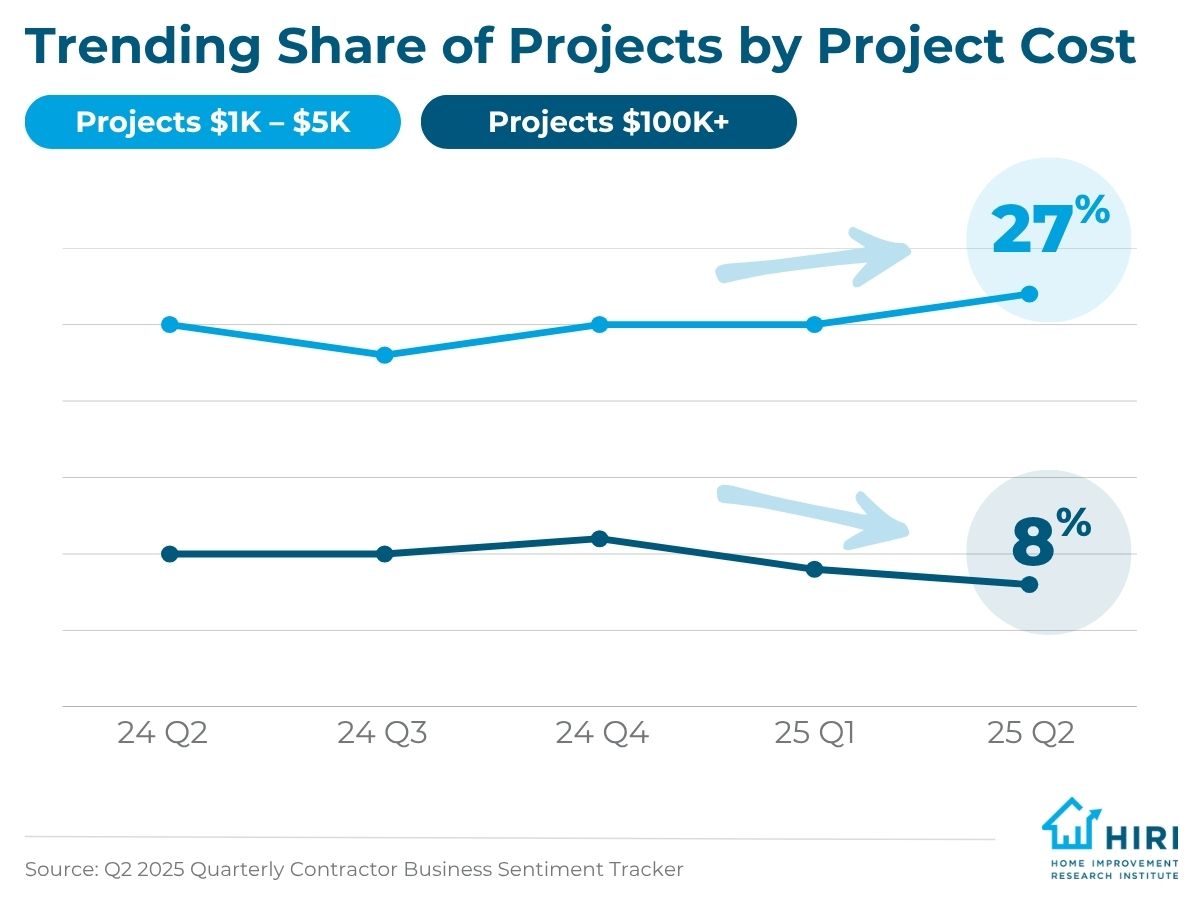
3. Market Growth Expectations are Softening
Contractor optimism dipped again during the second quarter of 2025, although the sector as a whole could still be described as “cautiously optimistic.” The study shows that only about half of contractors anticipate market growth in the next 12 months, which is down from Q1 and notably lower than 2024 levels. Additionally, revenue expectations also remain below prior-year highs. This could be a response to a variety of macroeconomic concerns and pressures, from trade tariffs and inflation to increased cost of living for homeowners and high material costs.
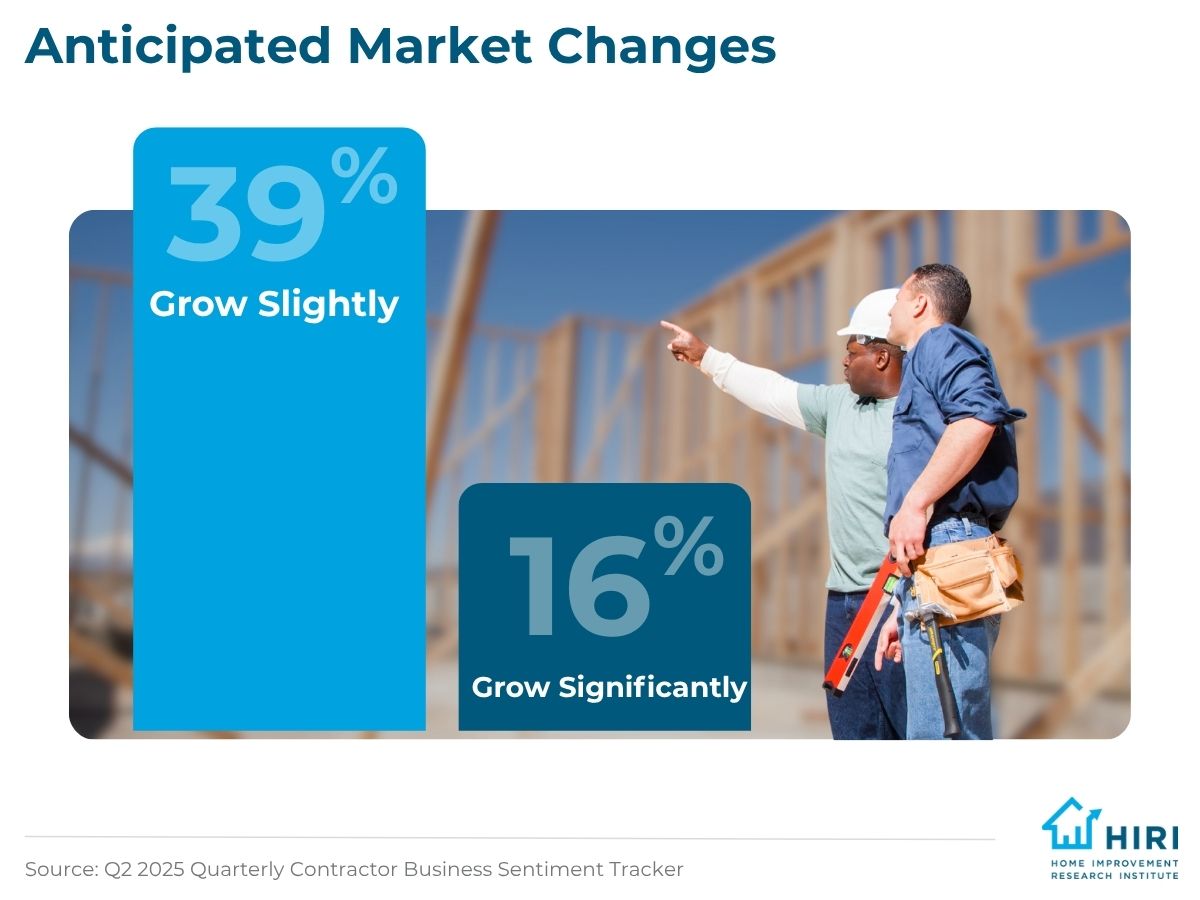
4. Competitive Pressure is Leveling Off
After a year of heightened competitive tension, market dynamics may be stabilizing. Only 52% of contractors believe there is now more competition, compared with 60% in the same quarter last year. At the same time, optimism around business revenue remains tempered. The majority of industry professionals anticipate their revenue will “grow slightly” in the next 12 months, but that is still below the percentages we observed in 2024, when optimism levels were relatively high.
5. Labor Availability Continues to be Top Challenge for Contractors
Several factors can contribute to home improvement jobs being postponed or canceled, such as schedule and material availability, but labor availability has been on the rise the past couple of quarters. About 43% of contractors report having experienced some sort of difficulty around labor in the past three months as well. Of those who experienced challenges in this area, availability was the top issue, followed by cost, with quality of labor and retention dipping slightly after both reaching a high last quarter.
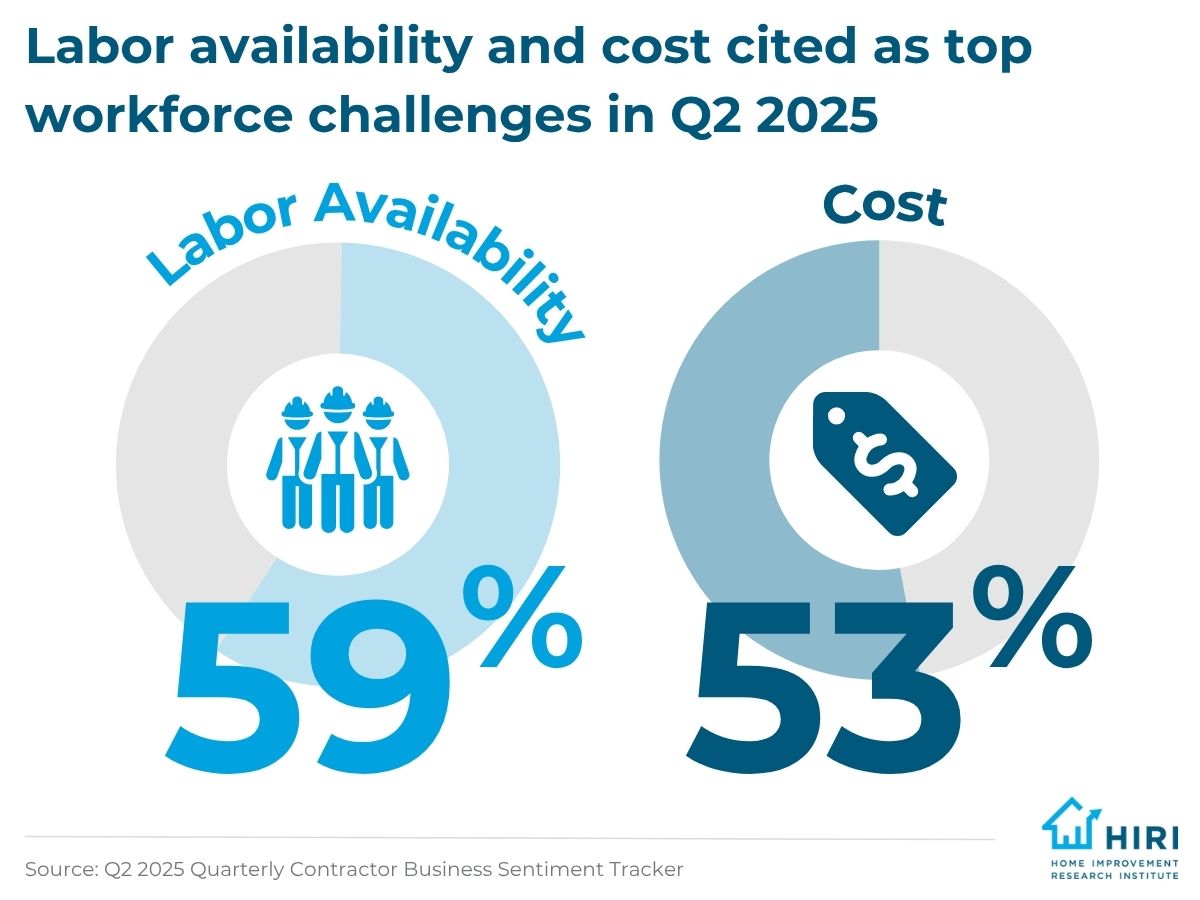
6. Tariffs and Material Costs Create Unease
Material costs and tariffs remain key macroeconomic concerns among industry professionals, affecting the outlook for the home improvement products market. In particular, material costs have been a source of pressure for several consecutive quarters. We’ve only more recently started tracking how contractors feel tariffs will impact their business over the next 12 months. The percentage of contractors citing tariffs as a major concern rose from 35% in the first quarter to 44% in the second quarter. The shift underscores growing unease over international cost strains. Meanwhile, inflationary pressure concerns continue to ease, which could be a good sign for building product brands.
7. Energy Efficiency and Tech Integration Seen as Opportunities for Growth
Looking ahead, about 44% of contractors feel like energy efficiency and renewable energy installations are the biggest opportunities for growth in the home improvement sector — a continuation of the opinion expressed in Q1. Technology integration is the second-highest category, although it saw a small decrease from earlier this year. Eco-friendly and health-conscious materials and sustainable and green renovations increased slightly in Q2. Based on these sentiments, building product brands might consider prioritizing cost management and positioning your products for energy-efficient and sustainable projects.
8. Outdoor Materials and Supplies Experience Seasonal Increase
When it comes to what home improvement contractors are purchasing the most, building materials and structural systems — from adhesive and drywall to lumber and fasteners — are consistently the top category. Landscaping supplies, standalone grills and/or firepits, and exterior paint also saw notable gains during Q2. While such seasonal demand can be expected, we’re also seeing a modest shift toward exterior project investments in general. To capitalize on this trend, it’s important to align advertising and promotions — as well as inventory — with seasonal outdoor demand.
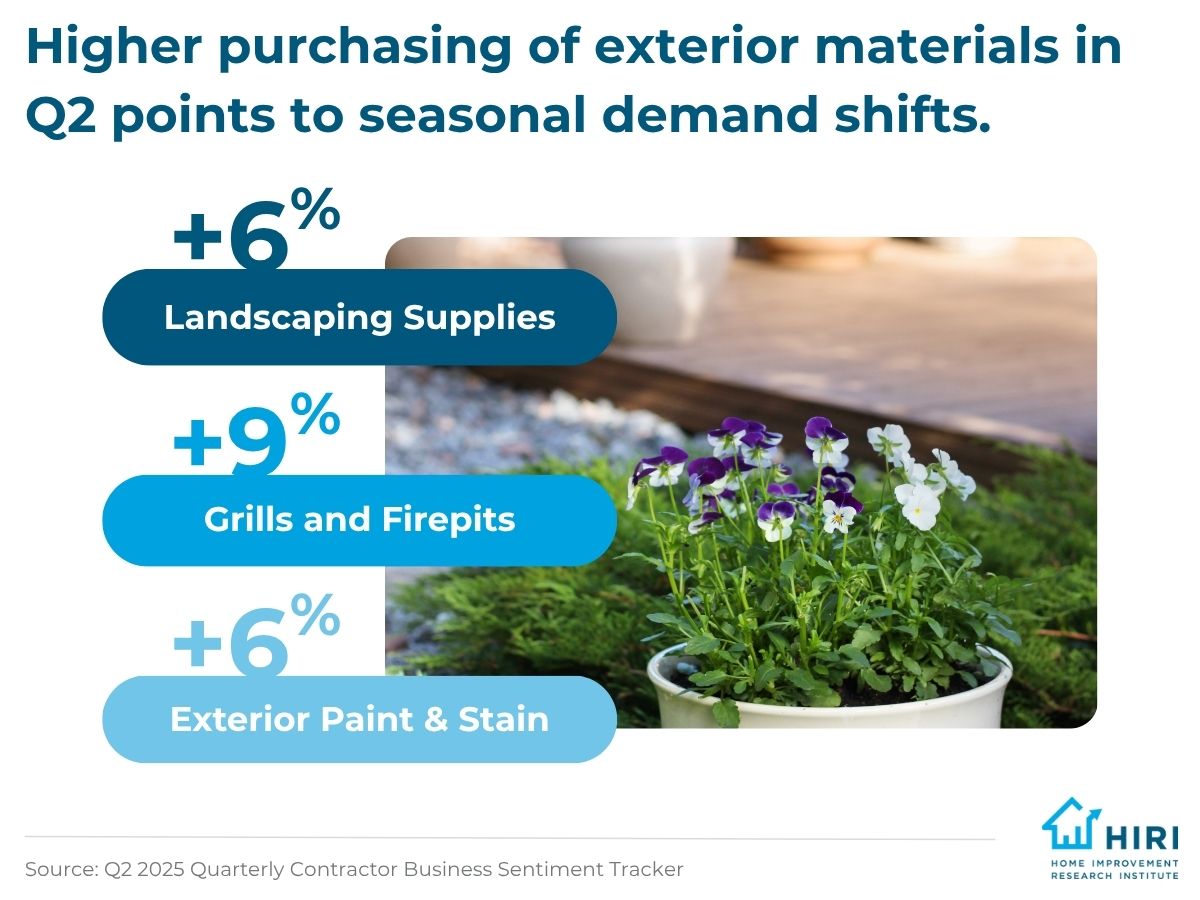
9. Competitive Bids are a Growing Challenge for Contractors
While material costs are a concern, contractors are also allocating a smaller percentage of their project bid to this cost, as opposed to labor and overhead. Along the same lines, our research shows that competitive bids have overtaken materials cost uncertainty as the top bidding challenge, with nearly half of contractors listing it as a challenge they faced in the past three months. Notably, budget constraints fell from 39% in Q1 to 28%. Labor cost uncertainty also dropped to a five-quarter low in terms of the bidding challenges currently facing contractors.
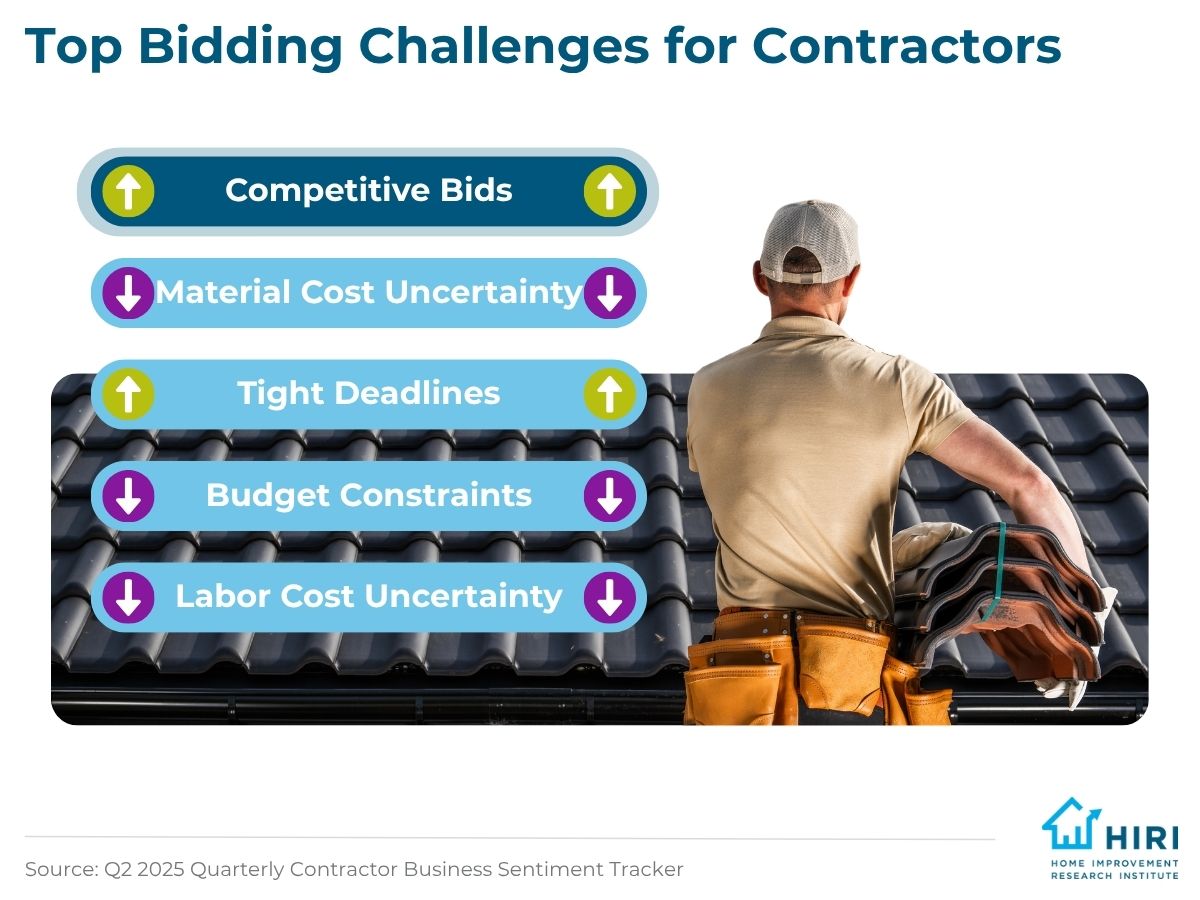
10. Product Availability, Delayed Payments and Indecision are Key Pain Points
When working on projects with homeowners, contractors are witnessing an increase in indecision, making it the most significant pain point. Cost constraints and timely payment are also consistent challenges. In terms of pain points when working with manufacturers, product availability has eased significantly from a sharp spike in Q1. The product delivery timeline also dropped. In comparison, poor product quality and lack of product support ticked upward.
Marketing to Home Improvement Contractors in 2025 and 2026
The construction industry is continually shaped by a variety of factors that influence contractors’ operations and strategic decision-making. The Quarterly Contractor Business Sentiment Tracker study, a collaboration between HIRI and The Farnsworth Group, evaluates the impact of broader economic trends, market conditions, interest rates, and the overall health of the housing industry on contractors’ businesses. As a HIRI member, you can access the full report and gain insight to help you effectively engage this critical customer base.
HIRI members have exclusive access to ~$1M of annual research, which covers Channel, Product, Project, and Market Size activity for both Homeowners/DIYers and Contractors. HIRI is the best source of secondary home improvement information. To leverage HIRI data ensures your organization has a strong, foundational comprehension of the industry and dynamics impacting it.

